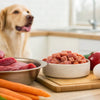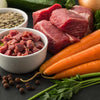Can I Switch My Dog to Raw Food? A Comprehensive Guide to Transitioning Your Pup Safely and Successfully
- Houndsy
Table of Contents
- Introduction
- Understanding Raw Dog Food Diets
- Preparing for the Transition to Raw Food
- The Transition Process
- What to Expect After Transitioning to Raw Food
- The Long-Term Benefits of Raw Feeding
- Maintaining a Balanced Raw Diet
- FAQs About Raw Dog Food Diets
- Conclusion
Introduction
Did you know that according to recent studies, sales of raw pet food have increased annually by over 15%, reflecting a significant trend among pet owners seeking healthier diets for their furry companions? As dog lovers, we understand the importance of providing our pets with the best possible nutrition, and many of us are exploring the idea of switching our dogs to a raw food diet. But can we really make that transition successfully, and what does it entail?
In this post, we will dive deep into the world of raw dog food, offering insight into what it means to switch to a raw diet, the benefits and challenges associated with this feeding approach, and how to facilitate a smooth transition for your pet. By reading through this guide, you’ll gain a comprehensive understanding of the raw food movement for dogs and how to make informed choices that suit your dog’s needs.
We'll explore everything from the basics of raw feeding to tips for making the transition as stress-free as possible. So, if you've been wondering, "Can I switch my dog to raw food?" you're certainly not alone, and we're here to help you navigate this decision. Let’s make feeding time not only nutritious but also enjoyable for our furry friends.
Understanding Raw Dog Food Diets
What is a Raw Dog Food Diet?
A raw dog food diet typically consists of raw meat, bones, fruits, vegetables, and organ meats, aimed at mimicking the natural feeding patterns of wild canines. This diet can be characterized by two main approaches: BARF (Biologically Appropriate Raw Food) and PMR (Prey Model Raw). The BARF model includes a variety of foods including ground meats, veggies, and dairy, whereas the PMR approach emphasizes a whole prey model, focusing on feeding the parts of an animal that a wild dog would consume.
The Appeal of Raw Feeding
Many pet parents choose to switch their dogs to raw food for a variety of reasons:
- Improved Health: Owners often report benefits such as healthier skin and coat, reduced allergies, better digestion, and increased energy.
- Weight Management: Raw diets can help maintain a healthy weight as they are often more nutrient-dense and devoid of fillers that commercial kibble contains.
- Natural Feeding: For many, raw feeding feels more in tune with how dogs are meant to eat, reflecting a more ancestral approach to pet nutrition.
Debunking Misconceptions
There are numerous myths surrounding raw feeding, leading some dog owners to be hesitant about making the switch. Common fears include the idea that feeding raw may lead to nutritional deficiencies or pose health risks to pets and families alike. However, when done correctly, raw diets can be complete and balanced. It is essential to do thorough research and consult with veterinarians who support raw feeding before making any changes.
Preparing for the Transition to Raw Food
Research and Preparation
Before diving into raw feeding, it’s crucial to understand the nutritional requirements of your dog. Each dog has unique dietary needs based on their age, weight, and health status. We recommend conducting thorough research to learn about raw feeding practices and ensure you’re providing a balanced diet.
Key areas to research include:
- Understanding how much to feed based on your dog’s size and energy level.
- Sourcing high-quality, trustworthy raw meat products.
- Familiarizing yourself with safe handling practices for raw ingredients.
Consulting with a Veterinarian
Before switching diets, it’s wise to review your plan with a veterinarian, particularly one experienced in raw feeding. Your vet can suggest specific dietary formulations that meet your dog's health needs, helping you avoid common pitfalls.
Setting Realistic Expectations
Transitioning to a raw diet can come with challenges. Each dog may react differently to dietary changes, and it's important to be patient and observant as your pet adjusts. Establishing realistic expectations will make the journey smoother for both you and your dog.
The Transition Process
Gradual vs. Instant Transition
When considering can I switch my dog to raw food, you’ll find that there are two primary approaches to transitioning: gradual and instant.
Gradual Transition
This method is highly recommended for most dogs, especially those who are used to a processed kibble diet. The process typically looks like this:
- Start Small: Introduce a small amount of raw food into your dog’s regular meals, such as substituting 10% of their kibble with 10% raw food.
- Increase Over Time: Gradually increase the ratio of raw food to kibble over one to six weeks, watching for any digestive upset or resistance to new flavors.
- Monitor Health: Pay close attention to your dog’s stool consistency and overall health throughout the transition.
Instant Transition
For more resilient dogs, or those with digestive systems that are not sensitive, an instant transition may work. This approach means switching to raw food overnight after a short fasting period (12-24 hours). It's vital to ensure your dog is healthy and has no pre-existing digestive issues before attempting this method.
Tips for a Successful Transition
- Choose Familiar Proteins: Start with meats that you know your dog enjoys. This encourages them to accept raw food more readily.
- Add Tasty Toppers: As an incentive, consider topping their meals with delicious raw treats or other add-ins like goat milk to enhance flavor.
- Consider Animal Organs: Organs are vital for a balanced raw diet. Incorporate them appropriately, but gradually to prevent digestive stress.
- Watch for Sensitivities: Monitor your pet for any adverse reactions to new foods, adjusting accordingly.
What to Expect After Transitioning to Raw Food
After transitioning, you may notice several changes in your dog:
- Changes in Digestive Patterns: Some dogs may experience mild digestive upset like gas or loose stools as their systems adapt. This typically subsides after a few days.
- Increased Energy: Many pet owners report a noticeable spike in energy levels after switching to raw food due to its nutrient-rich profile.
- Improved Coat Condition: A raw diet is often reflected in a healthier, shinier coat, with less shedding.
By being invested in these changes and adjusting as necessary, you contribute significantly to your dog's overall well-being.
The Long-Term Benefits of Raw Feeding
As we strive to improve our dog's nutrition, switching to a raw food diet can offer various benefits. Some pivotal advantages include:
- Enhanced Health: A raw diet can lead to fewer allergies and overall improved health.
- Better Weight Management: Owners often comment on their pet's well-maintained weight, which is easier to achieve with nutrient-dense foods.
- Increased Longevity: Healthy diets contribute to a better quality of life and can even extend a dog’s lifespan.
Maintaining a Balanced Raw Diet
Nutritional Guidelines
When feeding your dog raw, it's important to keep nutritional balance in mind. Here are some basic guidelines:
- Protein Source: About 70-80% of the diet should consist of muscle meat, which includes the meat from various animals.
- Bone Content: Aim for approximately 10% of the diet to consist of raw, edible bones, providing your dog with essential calcium and phosphorus.
- Organs: Include 10% organ meats to ensure your dog receives vital nutrients.
Ongoing Adjustments
After the initial transition phase, it’s essential to regularly assess your dog’s diet and make adjustments based on their health and activity levels. Keep in mind that your dog’s needs may change with age, activity, and health conditions, so being flexible is crucial.
FAQs About Raw Dog Food Diets
1. What are the risks associated with raw feeding?
While raw feeding has its benefits, it can also expose pets and owners to bacteria such as Salmonella and E. coli if proper handling and food safety practices are not followed. Always practice good hygiene and wash utensils, surfaces, and hands thoroughly after preparing raw food.
2. How do I know if the raw diet is working for my dog?
You should monitor your dog's energy levels, weight, coat condition, and stool quality. If your dog seems healthier and more energetic, it’s likely that the raw diet is providing the necessary nutrition.
3. Can all dogs handle a raw diet?
Most dogs can adapt well to raw food, but dogs with specific health conditions or sensitivities may need customized diets and should consult their veterinarian before transitioning.
4. How often should I feed my dog raw food?
Feeding schedules typically depend on your dog’s age and energy levels. Most adult dogs do well with two meals per day, but puppies may require more frequent feeding.
5. What should I do if my dog refuses to eat raw food?
If your dog is hesitant, alternatively try lightly warming the food or mixing it with a preferred topper initially. Gradual introduction and patience are key components in encouraging acceptance.
Conclusion
Making the decision to switch your dog to a raw food diet can be a significant change, one that requires thoughtful planning, research, and commitment. While it is normal to have questions and concerns during this process, understanding the potential benefits and challenges can help ease the transition.
By taking gradual steps, being mindful of your dog’s unique needs, and maintaining a balanced diet, we can transform mealtime into a more nourishing experience that contributes to our pets’ overall health and happiness. So as you ponder "Can I switch my dog to raw food?", embrace the opportunity for a healthier lifestyle for your furry friend.
To enhance your dog-feeding experience, consider the Houndsy Kibble Dispenser, designed thoughtfully for convenience, ensuring perfect portions of food every time without the need for bending down. Explore more about it here.
As we close this discussion, remember that your dog's health journey often begins with their diet. Embrace the changes with an open heart—after all, happy, healthy pets lead to joyful lives!












